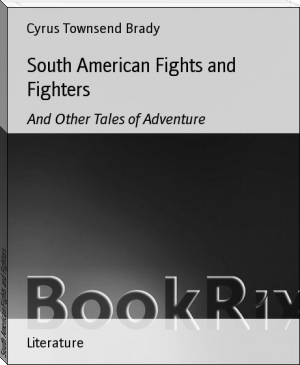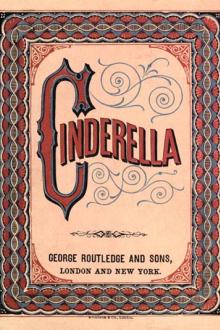South American Fights and Fighters, and Other Tales of Adventure by Brady (rosie project .txt) 📕

Read free book «South American Fights and Fighters, and Other Tales of Adventure by Brady (rosie project .txt) 📕» - read online or download for free at americanlibrarybooks.com
- Author: Brady
Read book online «South American Fights and Fighters, and Other Tales of Adventure by Brady (rosie project .txt) 📕». Author - Brady
"It was not enough that the Spanish soldier of that day was a bulldog for strength and courage, or that his armor was proof against stone arrows and lances, or that he wielded a Toledo blade that could cut through silken cushions, or that his arquebus and cannon were not only death-dealing weapons but objects of superstitious awe. More potent than all else together were those frightful monsters, the horses. Before these animals men, women, and children fled like sheep, or skulked and peeped from behind their walls in an ecstasy of terror. It was that paralyzing, blood-curdling fear of the supernatural, against which no amount of physical bravery, nothing in the world but modern knowledge, is of the slightest avail."
After touching at various places, in one of which they were lucky enough to find and release a Spanish captive named Geronimo de Aguilar, who had been wrecked on the Yucatan coast while on a voyage from the Spanish settlement in Darien and had been taken captive by the Mayas and held for several years. The hospitable Mayas had eaten most of the expedition. There were then but two alive. One had renounced his religion, married a Maya woman, and had been elected chieftain of the tribe, and accordingly refused to join Cortes. Aguilar was unfettered and glad of the opportunity. During his sojourn among the Mayas he had learned to speak their language fluently.
After landing at Tabasco on Good Friday, there was a great battle with the warlike inhabitants of that section, a battle which resulted in the complete {123} discomfiture of the Tabascans. The artillery did much to bring this about, but was not especially terrifying to the aborigines because they crowded in such numbers around the Spaniards, and made such terrific outcries, beating on their drums the while, that they drowned out the noise of the cannonade; but when Cortes at the head of the horsemen sallied out from the woods, and fell upon them, the strange, terrifying spectacle presented by these mail-clad monsters and demons, took the heart out of the Tabascans, and they abandoned the contest, leaving, so the chroniclers say, countless numbers dead upon the field.
They knew when they had had enough, and immediately thereafter, they sued for peace. Cortes was graciously pleased to grant their request, and to accept as a peace-offering a score of slaves. Among them was Malinal. In the allotment of the slaves among the officers, she fell to the share of Alonzo de Puerto Carrero from whom Cortes speedily acquired her.
Of all the Indians present with Cortes, Malinal alone could speak two languages. The Tabascans spoke a sort of degenerate Maya, with which, as she had lived among them so long, she was of course perfectly familiar, at the same time she had not forgotten her native Mexican. It would have been impossible for Cortes to have communicated with the Mexicans without Malinal, for Aguilar could turn Spanish into Maya, and Malinal could turn Maya into Mexican. This means of communication, round about though it might be, was at once established. The intervention of Aguilar soon became unnecessary, for Malinal presently learned to speak pure Castilian with fluency and grace. She received instruction from the worthy priests who accompanied the expedition and was {124} baptised under the name of Marina, and it is by that name that she is known in history. Her eminence is even greater than that unfortunate Florinda, whose father, to revenge her mistreatment by King Roderick, the Goth, sold Spain to Tarik, the Saracen, so many centuries before.
Marina learnt among other things to love Cortes, whose fortunes she followed and whom she served with an absolute, unquestioning, blind devotion and fidelity until the end. So absolute was this attachment of hers that Cortes became known to the Aztecs as the Lord of Marina. The Aztecs could not pronounce the letter R. Marina was therefore changed to Malina, which curiously enough was nearly her original name. The word "Tzin" is the Aztec name for Lord, consequently Cortes was called Malintzin, or more shortly Malinche, meaning, as has been stated, the Lord of Malina.
Sir Arthur Helps has this to say of her: "Indeed her fidelity was assured by the love which she bore her master. Bernal Diaz says that she was handsome, clever, and eager to be useful (one that will have an oar in every boat), and she looked the great lady that she was.
"There was hardly any person in history to whom the ruin of that person's native land can be so distinctly brought home, as it can be to the wicked mother of Donna Marina. Cortes, valiant and skilful as he was in the use of the sword, was not less valiant (perhaps we might say, not less audacious) nor less skilful, in the use of the tongue. All the craft which he afterward showed in negotiations would have been profitless without a competent and trusty interpreter.… If a medal had been struck to commemorate the deeds of {125} Cortes, the head of Donna Marina should have been associated with that of Cortes on the face of the medal; for, without her aid, his conquest of Mexico would never have been accomplished."
III. The Religion of the Aztecs
Now the Aztec Empire was a rather loose confederation of states bound together by allegiance to a common overlord, who had his capital across the mountains in the City of Mexico. It had been founded by the influx of an army of fierce marauders from the North who had overwhelmed the Toltecs who occupied the country and had attained a degree of civilization which is presumed to have been higher than that which displaced it. This Empire of Anahuac, as it was sometimes called, had endured for two centuries. It was a military despotism and the emperor was a military despot. His rule was the rule of fear. It subsisted by force of arms and terror was its cohering power. It had been extended by ruthless conquest alone until it comprised from eighteen hundred to two thousand square leagues, about two hundred thousand square miles of territory. The capital, situated on an island in the midst of a salt lake, was known as Tenochtitlan, or the City of Mexico, and what Rome was to the Italian states, or Carthage was to the north African literal, this city was to Anahuac, the empire of the Aztecs. The name Tenochtitlan is thus explained by Fiske:
"When the Aztecs, hard pressed by foes, took refuge among these marshes, they came upon a sacrificial stone which they recognized as one upon which some years before one of their priests had immolated a captive {126} chief. From a crevice in this stone, where a little earth was imbedded, there grew a cactus, upon which sat an eagle holding in its beak a serpent. A priest ingeniously interpretated this symbolism as a prophecy of signal and long-continued victory, and, forthwith diving into the lake, he had an interview with Tlaloc, the god of waters, who told him that upon that very spot the people were to build their town. The place was thereafter called Tenochtitlan, or "the place of the cactus-rock," but the name under which it afterward came to be best known was taken from Mexitl, one of the names of the war god Huitzilopochtli. The device of the rock, the cactus, with the eagle and the serpent, formed a tribal totem for the Aztecs, and has been adopted, as the coat-of-arms of the present Republic of Mexico."
Included in the sway of its emperor were many different tribes. They were kept in submission by the strong and inexorable hand. There were a few tribes, however, which had not been subdued and which still maintained a more or less precarious independence. The subject peoples were only kept from open rebellion by the most rigorous and oppressive measures. There was jealousy, humiliation, hoped-for revenge throughout the entire empire.
Each tribe or people had its own local god, but there was a bond coherent in the general Mexican religion that had its centre of worship in the great city, and which all of them followed. This religion was one of the most ferocious, degrading and disgusting of any in history. It required human sacrifice on a larger scale than had ever before been practised. Cannibalism was universal. Captives of war were sacrificed to the gods and their bodies eaten. In Mexico, {127} itself, with all its charm, with all its beauty, with all its luxuries, with all its verdure and wealth, there were huge pyramids of skulls. The priests were ferocious creatures, whose long black locks, never combed, were matted with blood, as they sacrificed to their awful war-god human hearts, still palpitating, torn from the victims a moment since alive. Fiske thus describes the temple pyramid and chief shrine in the great city:
"On the summit was a dreadful block of jasper, convex at the top, so that when the human victim was laid upon his back and held down, the breast was pushed upwards, ready for the priest to make one deep slashing cut and snatch out the heart. Near the sacrificial block were the altars, and sanctuaries of the gods, Tezcatlipoca, Huitzilopochtli, and others, with idols as hideous as their names. On these altars smoked fresh human hearts, of which the gods were fond, while other parts of the bodies were ready for the kitchens of the communal houses below. The gods were voracious as wolves, and the victims as numerous. In some cases the heart was thrust into the mouth of the idol with a golden spoon, in others the lips were simply daubed with blood. In the temple a great quantity of rattlesnakes, kept as sacred objects were fed with the entrails of the victims. Other parts of the body were given to the menagerie beasts, which were probably also kept for purposes of religious symbolism. Blood was also rubbed into the mouths of the carved serpents upon the jambs and lintels of the houses. The walls and floor of the great temple were clotted with blood and shreds of human flesh, and the smell was like that of a slaughter-house. Just outside the temple, in front of the broad street which {128} led across the causeway to Tlacopan, stood the tzompantli, which was an oblong parallelogram of earth and masonry, one hundred and fifty-four feet (long) at the base, ascended by thirty steps, on each of which were skulls. Round the summit were upward of seventy raised poles about four feet apart, connected by numerous rows of cross-poles passed through holes in the masts, on each of which five skulls were filed, the sticks being passed through the temples. In the centre stood two towers, or columns, made of skulls and lime, the face of each skull being turned outwards, and giving a horrible appearance to the whole. This effect was heightened by leaving the heads of distinguished captives in their natural state, with hair and skin on. As the skulls decayed they fell from the towers or poles, and they were replaced by others, so that no vacant place was left."
Concerning the cruelty of the Spaniards, the contrast between the opposing religions must be considered. Ruthless as the conquerors were, there is no possible comparison between the most indifferent principles of the Christian Religion and the application of the awful principles of the Mexican religion. MacNutt, the author of the latest and best life of Cortes, makes this interesting comment on the Christianity of the Spanish adventurers of the time:
"Soldier of Spain and soldier of the Cross, for the Cross was the standard of militant Christianity, of which Spain was the truest exponent, his religion, devoutly believed in, but intermittently practised, inspired his ideals, without sufficiently guiding his conduct. Ofttimes brutal, he was never vulgar, while as a lover of sheer daring and of danger for danger's sake, he has never been eclipsed.… {129} Sixteenth-century Spain produced a race of Christian warriors whose piety, born of an intense realization of, and love for a militant Christ, was of a martial complexion, beholding in the symbol of salvation—the Cross—the standard of Christendom around which the faithful must rally, and for whose protection and exaltation swords must be drawn and blood spilled if need be. They were the children of the generation which had expelled the Moor from Spain, and had brought centuries of religious and patriotic warfare to a triumphant





Comments (0)